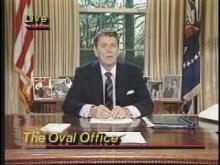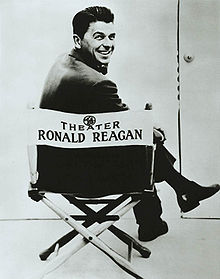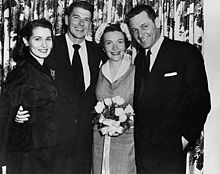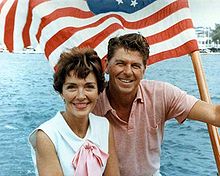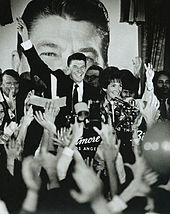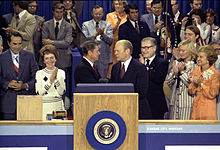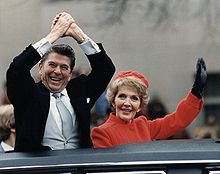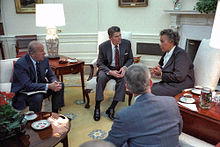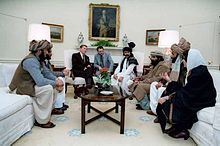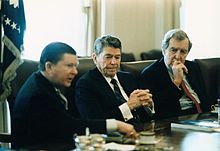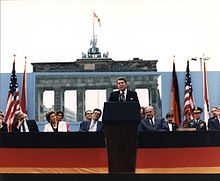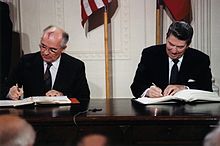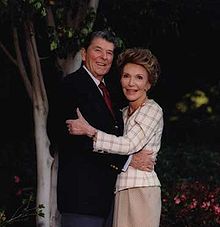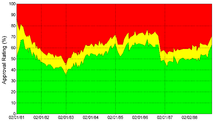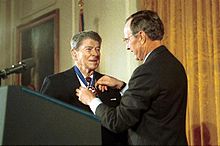
Ronald Reagan
Did you know...
This Wikipedia selection is available offline from SOS Children for distribution in the developing world. SOS Children is the world's largest charity giving orphaned and abandoned children the chance of family life.
| Ronald Reagan | |
|---|---|
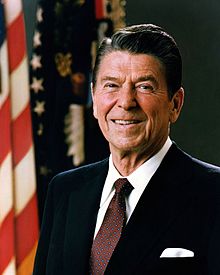 |
|
| 40th President of the United States | |
| In office January 20, 1981 – January 20, 1989 |
|
| Vice President | George H. W. Bush |
| Preceded by | Jimmy Carter |
| Succeeded by | George H. W. Bush |
| 33rd Governor of California | |
| In office January 2, 1967 – January 6, 1975 |
|
| Lieutenant | Robert Finch Edwin Reinecke John Harmer |
| Preceded by | Pat Brown |
| Succeeded by | Jerry Brown |
| Personal details | |
| Born | Ronald Wilson Reagan February 6, 1911 Tampico, Illinois, U.S. |
| Died | June 5, 2004 (aged 93) Los Angeles, California, U.S. |
| Resting place | Ronald Reagan Presidential Library, Simi Valley, California, U.S. 34°15′35.5896″N 118°49′11.301″W |
| Political party | Republican (1962–2004) |
| Other political affiliations |
Democratic (Before 1962) |
| Spouse(s) | Jane Wyman (1940–1949) Nancy Davis (1952–2004) |
| Children | Maureen Reagan Christine Reagan Michael Reagan (adopted) Patti Davis Ron Reagan |
| Alma mater | Eureka College |
| Profession | Actor (1937-1965) Politician (1967-1989) |
| Religion | Disciples of Christ later Presbyterian |
| Signature | |
| Military service | |
| Service/branch | United States Army United States Army Air Forces |
| Years of service | 1937–45 |
| Rank | |
Ronald Wilson Reagan ( / ˈ r ɒ n əl d ˈ w ɪ l s ən ˈ r eɪ ɡ ən /; February 6, 1911 – June 5, 2004) was the 40th President of the United States (1981–1989). Before that, he was the 33rd Governor of California (1967–1975), and a radio, film and television actor.
Born in Tampico, Illinois, and raised in Dixon, Reagan was educated at Eureka College, earning a Bachelor of Arts degree in economics and sociology. After graduating, Reagan moved first to Iowa to work as a radio broadcaster and then, in 1937, to Los Angeles where he began a career as an actor, first in films and later television. Some of his most notable films include Knute Rockne, All American (1940), Kings Row (1942), and Bedtime for Bonzo (1951). Reagan served as President of the Screen Actors Guild and later as a spokesman for General Electric (GE); his start in politics occurred during his work for GE. Originally a member of the Democratic Party, his positions began shifting rightward in the 1950s, and he switched to the Republican Party in 1962.
After delivering a rousing speech in support of Barry Goldwater's presidential candidacy in 1964, he was persuaded to seek the California governorship, winning two years later and again in 1970. He was defeated in his run for the Republican presidential nomination in 1968 and in 1976, but won both the nomination and general election in 1980, defeating incumbent Jimmy Carter.
As president, Reagan implemented sweeping new political and economic initiatives. His supply-side economic policies, dubbed " Reaganomics", advocated reducing tax rates to spur economic growth, controlling the money supply to reduce inflation, deregulation of the economy, and reducing government spending. In his first term he survived an assassination attempt, took a hard line against labor unions, announced a new War on Drugs, and ordered an invasion of Grenada. He was re-elected in a landslide in 1984, proclaiming that it was " Morning in America". His second term was primarily marked by foreign matters, such as the ending of the Cold War, the 1986 bombing of Libya, and the revelation of the Iran–Contra affair. Publicly describing the Soviet Union as an " evil empire", he supported anti-communist movements worldwide and spent his first term forgoing the strategy of détente by ordering a massive military buildup in an arms race with the USSR. Reagan negotiated with Soviet General Secretary Mikhail Gorbachev, culminating in the INF Treaty and the decrease of both countries' nuclear arsenals.
Reagan left office in 1989. In 1994, the former president disclosed that he had been diagnosed with Alzheimer's disease earlier in the year; he died ten years later at the age of 93. A conservative icon, he ranks highly in public opinion polls of U.S. Presidents and is credited for generating an ideological renaissance on the American political right.
Early life
Ronald Wilson Reagan was born in an apartment on the second floor of a commercial building in Tampico, Illinois on February 6, 1911, to Jack Reagan and Nelle (Wilson) Reagan. Reagan's father was a salesman and a storyteller, the grandson of Irish Catholic immigrants from County Tipperary while his mother had Scots and English ancestors. Reagan had one sibling, his older brother, Neil (1908–1996), who became an advertising executive. As a boy, Reagan's father nicknamed his son "Dutch", due to his "fat little Dutchman"-like appearance, and his "Dutchboy" haircut; the nickname stuck with him throughout his youth. Reagan's family briefly lived in several towns and cities in Illinois, including Monmouth, Galesburg and Chicago, until 1919, when they returned to Tampico and lived above the H. C. Pitney Variety Store. After his election as president, residing in the upstairs White House private quarters, Reagan would quip that he was "living above the store again".
According to Paul Kengor, author of God and Ronald Reagan, Reagan had a particularly strong faith in the goodness of people, which stemmed from the optimistic faith of his mother, Nelle, and the Disciples of Christ faith, which he was baptized into in 1922. For the time, Reagan was unusual in his opposition to racial discrimination, and recalled a time in Dixon when the local inn would not allow black people to stay there. Reagan brought them back to his house, where his mother invited them to stay the night and have breakfast the next morning.
Following the closure of the Pitney Store in late 1920, the Reagans moved to Dixon; the midwestern "small universe" had a lasting impression on Reagan. He attended Dixon High School, where he developed interests in acting, sports, and storytelling. His first job was as a lifeguard at the Rock River in Lowell Park, near Dixon, in 1927. Reagan performed 77 rescues as a lifeguard, noting that he notched a mark on a wooden log for every life he saved. Reagan attended Eureka College, where he became a member of the Tau Kappa Epsilon fraternity, a cheerleader, and majored in economics and sociology. He developed a reputation as a jack of all trades, excelling in campus politics, sports and theatre. He was a member of the football team, captain of the swim team and was elected student body president. As student president, Reagan led a student revolt against the college president after he tried to cut back the faculty.
Entertainment career
Radio and film
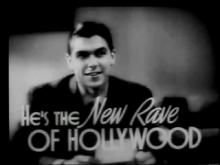
After graduating from Eureka in 1932, Reagan drove himself to Iowa, where he auditioned for a job at many small-town radio stations. The University of Iowa hired him to broadcast home football games for the Hawkeyes. He was paid $10 per game. Soon after, a staff announcer's job opened at radio station WOC in Davenport, and Reagan was hired, now earning $100 per month. Aided by his persuasive voice, he moved to WHO radio in Des Moines as an announcer for Chicago Cubs baseball games. His specialty was creating play-by-play accounts of games that the station received by wire.
While traveling with the Cubs in California, Reagan took a screen test in 1937 that led to a seven-year contract with Warner Brothers studios. He spent the first few years of his Hollywood career in the " B film" unit, where, Reagan joked, the producers "didn't want them good, they wanted them Thursday". While sometimes overshadowed by other actors, Reagan's screen performances did receive many good reviews.
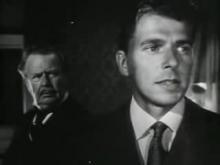
His first screen credit was the starring role in the 1937 movie Love Is on the Air, and by the end of 1939 he had already appeared in 19 films, including Dark Victory with Bette Davis and Humphrey Bogart. Before the film Santa Fe Trail with Errol Flynn in 1940, he played the role of George "The Gipper" Gipp in the film Knute Rockne, All American; from it, he acquired the lifelong nickname "the Gipper". In 1941 exhibitors voted him the fifth most popular star from the younger generation in Hollywood.
Reagan's favorite acting role was as a double amputee in 1942's Kings Row, in which he recites the line, "Where's the rest of me?", later used as the title of his 1965 autobiography. Many film critics considered Kings Row to be his best movie, though the film was condemned by New York Times critic Bosley Crowther.
Although Reagan called Kings Row the film that "made me a star", he was unable to capitalize on his success because he was ordered to active duty with the U.S. Army at San Francisco two months after its release, and never regained "star" status in motion pictures. In the post-war era, after being separated from almost four years of World War II stateside service with the 1st Motion Picture Unit in December 1945, Reagan co-starred in such films as, The Voice of the Turtle, John Loves Mary, The Hasty Heart, Bedtime for Bonzo, Cattle Queen of Montana, Tennessee's Partner, Hellcats of the Navy and The Killers (his final film) in a 1964 remake. Throughout his film career, his mother often answered much of his fan mail.
Military service
After completing fourteen home-study Army Extension Courses, Reagan enlisted in the Army Enlisted Reserve on April 29, 1937, as a private assigned to Troop B, 322nd Cavalry at Des Moines, Iowa. He was commissioned a second lieutenant in the Officers Reserve Corps of the cavalry on May 25, 1937.
Reagan was ordered to active duty for the first time on April 18, 1942. Due to his nearsightedness, he was classified for limited service only, which excluded him from serving overseas. His first assignment was at the San Francisco Port of Embarkation at Fort Mason, California, as a liaison officer of the Port and Transportation Office. Upon the approval of the Army Air Force (AAF), he applied for a transfer from the cavalry to the AAF on May 15, 1942, and was assigned to AAF Public Relations and subsequently to the First Motion Picture Unit (officially, the "18th Army Air Force Base Unit") in Culver City, California. On January 14, 1943, he was promoted to first lieutenant and was sent to the Provisional Task Force Show Unit of This Is The Army at Burbank, California. He returned to the First Motion Picture Unit after completing this duty and was promoted to captain on July 22, 1943.
In January 1944, Reagan was ordered to temporary duty in New York City to participate in the opening of the Sixth War Loan Drive. He was re-assigned to the First Motion Picture Unit on November 14, 1944, where he remained until the end of World War II. He was recommended for promotion to major on February 2, 1945, but this recommendation was disapproved on July 17 of that year. While with the First Motion Picture Unit in 1945, he was indirectly involved in discovering actress Marilyn Monroe. He returned to Fort MacArthur, California, where he was separated from active duty on December 9, 1945. By the end of the war, his units had produced some 400 training films for the AAF.
Reagan never left the United States during the war, though he kept a film reel, obtained while in the service, depicting the liberation of Auschwitz, as he believed that someday doubts would arise as to whether the Holocaust had occurred. It has been alleged that he was overheard telling Israeli foreign minister Yitzhak Shamir in 1983 that he had filmed that footage himself and helped liberate Auschwitz, though this purported conversation was disputed by Secretary of State George Shultz.
SAG president
Reagan was first elected to the Board of Directors of the Screen Actors Guild in 1941, serving as an alternate. Following World War II, he resumed service and became 3rd vice-president in 1946. The adoption of conflict-of-interest bylaws in 1947 led the SAG president and six board members to resign; Reagan was nominated in a special election for the position of president and subsequently elected. He was subsequently chosen by the membership to serve seven additional one-year terms, from 1947 to 1952 and in 1959. Reagan led SAG through eventful years that were marked by labor-management disputes, the Taft-Hartley Act, House Committee on Un-American Activities (HUAC) hearings and the Hollywood blacklist era.
Secret FBI informant in Hollywood
During the late 1940s, Reagan and his wife provided the FBI with names of actors within the motion picture industry whom they believed to be communist sympathizers, though he expressed reservations; he said "Do they expect us to constitute ourselves as a little FBI of our own and determine just who is a Commie and who isn't?".
Reagan testified before the House Un-American Activities Committee on the subject as well. A fervent anti-communist, he reaffirmed his commitment to democratic principles, stating, "I never as a citizen want to see our country become urged, by either fear or resentment of this group, that we ever compromise with any of our democratic principles through that fear or resentment."
Television
Though an early critic of television, Reagan landed fewer film roles in the late 1950s and decided to join the medium. He was hired as the host of General Electric Theatre, a series of weekly dramas that became very popular. His contract required him to tour GE plants sixteen weeks out of the year, often demanding of him fourteen speeches per day. He earned approximately $125,000 per year (about $1.07 million in 2010 dollars) in this role. His final work as a professional actor was as host and performer from 1964 to 1965 on the television series Death Valley Days. Reagan and Nancy Davis appeared together several times, including an episode of GE Theatre in 1958 called A Turkey for the President.
Marriages and children
In 1938, Reagan co-starred in the film Brother Rat with actress Jane Wyman (1917–2007). They were engaged at the Chicago Theatre, and married on January 26, 1940, at the Wee Kirk o' the Heather church in Glendale, California. Together they had two biological children, Maureen (1941–2001) and Christine (who was born in 1947 but only lived one day), and adopted a third, Michael (born 1945). Following arguments about Reagan's political ambitions, Wyman filed for divorce in 1948, citing a distraction due to her husband's Screen Actors Guild union duties; the divorce was finalized in 1949. He is the only US president to have been divorced.
Reagan met actress Nancy Davis (born 1921) in 1949 after she contacted him in his capacity as president of the Screen Actors Guild to help her with issues regarding her name appearing on a communist blacklist in Hollywood (she had been mistaken for another Nancy Davis). She described their meeting by saying, "I don't know if it was exactly love at first sight, but it was pretty close." They were engaged at Chasen's restaurant in Los Angeles and were married on March 4, 1952, at the Little Brown Church in the San Fernando Valley. Actor William Holden served as best man at the ceremony. They had two children: Patti (born October 21, 1952) and Ron (born May 20, 1958).
Observers described the Reagans' relationship as close, authentic and intimate. During his presidency they were reported to frequently display their affection for one another; one press secretary said, "They never took each other for granted. They never stopped courting." He often called her "Mommy" she called him "Ronnie". He once wrote to her, "Whatever I treasure and enjoy ... all would be without meaning if I didn't have you." When he was in the hospital in 1981, she slept with one of his shirts to be comforted by his scent. In a letter to U.S. citizens written in 1994, Reagan wrote "I have recently been told that I am one of the millions of Americans who will be afflicted with Alzheimer's disease.... I only wish there was some way I could spare Nancy from this painful experience", and in 1998, while Reagan was stricken by Alzheimer's, Nancy told Vanity Fair, "Our relationship is very special. We were very much in love and still are. When I say my life began with Ronnie, well, it's true. It did. I can't imagine life without him."
Early political career
Reagan began his political career as a Democrat and, in December 1945, was only prevented from leading an anti-nuclear rally in Hollywood by pressure from the Warner Brothers studio. He would later make his crusade against nuclear weapons a key point of his Presidency, building on previous efforts to limit the spread of nuclear weapons to a new focus to reduce the numbers and types of them. However, in the early 1950s, as his relationship with Republican actress Nancy Davis grew, he shifted to the right and, while remaining a Democrat, endorsed the presidential candidacies of Dwight D. Eisenhower in 1952 and 1956 as well as Richard Nixon in 1960. The last time Reagan actively supported a Democratic candidate was in 1950 when he helped Helen Gahagan Douglas in her unsuccessful Senate campaign against Richard Nixon.
After being hired in 1954 to host the General Electric Theatre, a TV drama series, Reagan soon began to embrace the conservative views of the sponsoring company's officials. His many GE speeches—which he wrote himself—were non-partisan but carried a conservative, pro-business message; he was influenced by Lemuel Boulware, a senior GE executive. Boulware, known for his tough stance against unions and his innovative strategies to win over workers, championed the core tenets of modern American conservatism: free markets, anticommunism, lower taxes, and limited government. Eventually, the ratings for Reagan's show fell off and GE dropped Reagan in 1962. In August of that year, Reagan formally switched to the Republican Party, stating, "I didn't leave the Democratic Party. The party left me".
In the early 1960s Reagan opposed certain civil rights legislation, saying that "if an individual wants to discriminate against Negroes or others in selling or renting his house, it is his right to do so." In his rationale, he cited his opposition to government intrusion into personal freedoms, as opposed to racism; he strongly denied having racist motives and later reversed his opposition to voting rights and fair housing laws. When legislation that would become Medicare was introduced in 1961, Reagan created a recording for the American Medical Association warning that such legislation would mean the end of freedom in America. Reagan said that if his listeners did not write letters to prevent it, "we will awake to find that we have socialism. And if you don't do this, and if I don't do it, one of these days, you and I are going to spend our sunset years telling our children, and our children's children, what it once was like in America when men were free." He also joined the National Rifle Association and would become a lifetime member.
Reagan endorsed the campaign of conservative presidential contender Barry Goldwater in 1964. Speaking for Goldwater, Reagan stressed his belief in the importance of smaller government. He revealed his ideological motivation in a famed speech delivered on October 27, 1964: "The Founding Fathers knew a government can't control the economy without controlling people. And they knew when a government sets out to do that, it must use force and coercion to achieve its purpose. So we have come to a time for choosing." He also said, "You and I are told we must choose between a left or right, but I suggest there is no such thing as a left or right. There is only an up or down. Up to man's age-old dream – the maximum of individual freedom consistent with order – or down to the ant heap of totalitarianism." This " A Time for Choosing" speech, which later became known as "The Speech", raised $1 million for Goldwater's campaign and is considered the event that launched Reagan's political career.
Governor of California, 1967–1975
California Republicans were impressed with Reagan's political views and charisma after his "Time for Choosing" speech, and nominated him for Governor of California in 1966. In Reagan's campaign, he emphasized two main themes: "to send the welfare bums back to work", and, in reference to burgeoning anti-war and anti-establishment student protests at the University of California at Berkeley, "to clean up the mess at Berkeley". He was elected, defeating two-term governor Edmund G. "Pat" Brown, and was sworn in on January 2, 1967. In his first term, he froze government hiring and approved tax hikes to balance the budget.
Shortly after the beginning of his term, Reagan tested the presidential waters in 1968 as part of a "Stop Nixon" movement, hoping to cut into Nixon's Southern support and be a compromise candidate if neither Nixon nor second-place Nelson Rockefeller received enough delegates to win on the first ballot at the Republican convention. However, by the time of the convention Nixon had 692 delegate votes, 25 more than he needed to secure the nomination, followed by Rockefeller with Reagan in third place.
Reagan was involved in high-profile conflicts with the protest movements of the era. On May 15, 1969, during the People's Park protests at UC Berkeley, Reagan sent the California Highway Patrol and other officers to quell the protests, in an incident that became known as "Bloody Thursday", resulting in the death of student James Rector and the blinding of carpenter Alan Blanchard. Reagan then called out 2,200 state National Guard troops to occupy the city of Berkeley for two weeks to crack down on the protesters. A year after "Bloody Thursday", Reagan responded to questions about campus protest movements saying, "If it takes a bloodbath, let's get it over with. No more appeasement." When the Symbionese Liberation Army kidnapped Patty Hearst in Berkeley and demanded the distribution of food to the poor, Reagan joked, "It's just too bad we can't have an epidemic of botulism."

Early in 1967, the national debate on abortion was beginning. Democratic California state senator Anthony Beilenson introduced the "Therapeutic Abortion Act", in an effort to reduce the number of "back-room abortions" performed in California. The State Legislature sent the bill to Reagan's desk where, after many days of indecision, he signed it. About two million abortions would be performed as a result, most because of a provision in the bill allowing abortions for the well-being of the mother. Reagan had been in office for only four months when he signed the bill, and stated that had he been more experienced as governor, it would not have been signed. After he recognized what he called the "consequences" of the bill, he announced that he was pro-life. He maintained that position later in his political career, writing extensively about abortion.
Despite an unsuccessful attempt to recall him in 1968, Reagan was re-elected in 1970, defeating "Big Daddy" Jesse Unruh. He chose not to seek a third term in the following election cycle. One of Reagan's greatest frustrations in office concerned capital punishment, which he strongly supported. His efforts to enforce the state's laws in this area were thwarted when the Supreme Court of California issued its People v. Anderson decision, which invalidated all death sentences issued in California prior to 1972, though the decision was later overturned by a constitutional amendment. The only execution during Reagan's governorship was on April 12, 1967, when Aaron Mitchell's sentence was carried out by the state in San Quentin's gas chamber.
In 1969, Reagan, as Governor, signed the Family Law Act which was the first no-fault divorce legislation in the United States.
Reagan's terms as governor helped to shape the policies he would pursue in his later political career as president. By campaigning on a platform of sending "the welfare bums back to work", he spoke out against the idea of the welfare state. He also strongly advocated the Republican ideal of less government regulation of the economy, including that of undue federal taxation.
Reagan did not seek re-election to a third term as governor in 1974 and was succeeded by Democratic California Secretary of State Jerry Brown on January 6, 1975.
1976 presidential campaign
In 1976, Reagan challenged incumbent President Gerald Ford in a bid to become the Republican Party's candidate for president. Reagan soon established himself as the conservative candidate with the support of like-minded organizations such as the American Conservative Union which became key components of his political base, while President Ford was considered a more moderate Republican.
Reagan's campaign relied on a strategy crafted by campaign manager John Sears of winning a few primaries early to damage the inevitability of Ford's likely nomination. Reagan won North Carolina, Texas, and California, but the strategy failed, as he ended up losing New Hampshire, Florida, and his native Illinois. The Texas campaign lent renewed hope to Reagan, when he swept all ninety-six delegates chosen in the May 1 primary, with four more awaiting at the state convention. Much of the credit for that victory came from the work of three co-chairmen, including Ernest Angelo, the mayor of Midland, and Ray Barnhart of Houston, whom President Reagan tapped in 1981 as director of the Federal Highway Administration.
However, as the GOP convention neared, Ford appeared close to victory. Acknowledging his party's moderate wing, Reagan chose moderate Senator Richard Schweiker of Pennsylvania as his running mate if nominated. Nonetheless, Ford prevailed with 1,187 delegates to Reagan's 1,070. Ford would go on to lose the 1976 Presidential election to the Democrat Jimmy Carter.
Reagan's concession speech emphasized the dangers of nuclear war and the threat posed by the Soviet Union. Though he lost the nomination, he received 307 write-in votes in New Hampshire, 388 votes as an Independent on Wyoming's ballot, and a single electoral vote from a faithless elector in the November election from the state of Washington, which Ford had won over Democratic challenger Jimmy Carter.
Following the campaign, Reagan remained in the public debate with the Ronald Reagan Radio Commentary series.
1980 presidential campaign
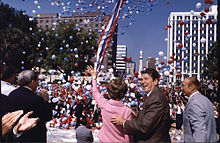
The 1980 presidential campaign between Reagan and incumbent President Jimmy Carter was conducted during domestic concerns and the ongoing Iran hostage crisis. His campaign stressed some of his fundamental principles: lower taxes to stimulate the economy, less government interference in people's lives, states' rights, a strong national defense, and restoring the U.S. Dollar to a gold standard.
Reagan launched his campaign by declaring "I believe in states' rights", in Philadelphia, Mississippi, known at the time for the murder of three civil rights workers who had been trying to register African-Americans to vote during the civil rights movement. After receiving the Republican nomination, Reagan selected one of his primary opponents, George H.W. Bush, to be his running mate. His showing in the October televised debate boosted his campaign. Reagan won the election, carrying 44 states with 489 electoral votes to 49 electoral votes for Carter (representing six states and Washington, D.C.). Reagan received 50.7% of the popular vote while Carter took 41%, and Independent John B. Anderson (a liberal Republican) received 6.7%. Republicans captured the Senate for the first time since 1952, and gained 34 House seats, but the Democrats retained a majority.
During the presidential campaign, questions were raised by reporters on Reagan's stance on the Briggs Initiative, also known as Proposition 6, a ballot initiative in Reagan's home state of California where he was governor, which would have banned gays, lesbians, and supporters of LGBT rights from working in public schools in California. His opposition to the initiative was instrumental in its landslide defeat by Californian voters. Reagan published an editorial in which he stated "homosexuality is not a contagious disease like the measles", and that prevailing scientific opinion was that a child's sexual orientation cannot be influenced by someone else.
Presidency, 1981–1989
During his Presidency, Reagan pursued policies that reflected his personal belief in individual freedom, brought changes domestically, both to the U.S. economy and expanded military, and contributed to the end of the Cold War. Termed the Reagan Revolution, his presidency would reinvigorate American morale and reduce the people's reliance upon government. As president, Reagan kept a series of diaries in which he commented on daily occurrences of his presidency and his views on the issues of the day. The diaries were published in May 2007 in the bestselling book, The Reagan Diaries.
First term, 1981–1985
To date, Reagan is the oldest man elected to the office of the presidency (at 69). In his first inaugural address on January 20, 1981, which Reagan himself wrote, he addressed the country's economic malaise arguing: "In this present crisis, government is not the solution to our problems; government is the problem."
Assassination attempt
On March 30, 1981, only 69 days into the new administration, Reagan, his press secretary James Brady, Washington police officer Thomas Delahanty, and Secret Service agent Timothy McCarthy were struck by gunfire from would-be assassin John Hinckley, Jr. outside the Washington Hilton Hotel. Although "close to death" upon arrival at George Washington University Hospital, Reagan was stabilized in the emergency room, then underwent emergency exploratory surgery. He recovered and was released from the hospital on April 11, becoming the first serving U.S. President to survive being shot in an assassination attempt. The attempt had great influence on Reagan's popularity; polls indicated his approval rating to be around 73%. Reagan believed that God had spared his life so that he might go on to fulfill a greater purpose.
Air traffic controllers' strike
In summer 1981 PATCO, the union of federal air traffic controllers went on strike, violating a federal law prohibiting government unions from striking. Declaring the situation an emergency as described in the 1947 Taft–Hartley Act, Reagan stated that if the air traffic controllers "do not report for work within 48 hours, they have forfeited their jobs and will be terminated". They did not return and on August 5, Reagan fired 11,345 striking air traffic controllers who had ignored his order, and used supervisors and military controllers to handle the nation's commercial air traffic until new controllers could be hired and trained. As a leading reference work on public administration concluded, "The firing of PATCO employees not only demonstrated a clear resolve by the president to take control of the bureaucracy, but it also sent a clear message to the private sector that unions no longer needed to be feared."
"Reaganomics" and the economy
During Jimmy Carter's last year in office (1980), inflation averaged 12.5%, compared with 4.4% during Reagan's last year in office (1988). During Reagan's administration, the unemployment rate declined from 7.5% to 5.4%, with the rate reaching highs of 10.8% in 1982 and 10.4% in 1983, averaging 7.5% over the eight years.
Reagan implemented policies based on supply-side economics and advocated a classical liberal and laissez-faire philosophy, seeking to stimulate the economy with large, across-the-board tax cuts. He also supported returning the U.S. to some sort of gold standard, and successfully urged Congress to establish the U.S. Gold Commission to study how one could be implemented. Citing the economic theories of Arthur Laffer, Reagan promoted the proposed tax cuts as potentially stimulating the economy enough to expand the tax base, offsetting the revenue loss due to reduced rates of taxation, a theory that entered political discussion as the Laffer curve. Reaganomics was the subject of debate with supporters pointing to improvements in certain key economic indicators as evidence of success, and critics pointing to large increases in federal budget deficits and the national debt. His policy of " peace through strength" (also described as "firm but fair") resulted in a record peacetime defense buildup including a 40% real increase in defense spending between 1981 and 1985.
During Reagan's presidency, federal income tax rates were lowered significantly with the signing of the bipartisan Economic Recovery Tax Act of 1981 which lowered the top marginal tax bracket from 70% to 50% and the lowest bracket from 14% to 11%, however other tax increases passed by Congress and signed by Reagan, ensured that tax revenues over his two terms were 18.2% of GDP as compared to 18.1% over the 40-year period 1970-2010. Then, in 1982 the Job Training Partnership Act of 1982 was signed into law, initiating one of the nation's first public/private partnerships and a major part of the president's job creation program. Reagan's Assistant Secretary of Labor and Chief of Staff, Al Angrisani, was a primary architect of the bill. The Tax Reform Act of 1986, another bipartisan effort championed by Reagan, further reduced the top rate to 28%, raised the bottom bracket from 11% to 15%, and, cut the number of tax brackets to 4.
Conversely, Congress passed and Reagan signed into law tax increases of some nature in every year from 1981 to 1987 to continue funding such government programs as Tax Equity and Fiscal Responsibility Act of 1982 (TEFRA), Social Security, and the Deficit Reduction Act of 1984 (DEFRA). Despite the fact that TEFRA was the "largest peacetime tax increase in American history", Reagan is better known for his tax cuts and lower-taxes philosophy. Real gross domestic product (GDP) growth recovered strongly after the early 1980s recession ended in 1982, and grew during his eight years in office at an annual rate of 3.85% per year. Unemployment peaked at 10.8% monthly rate in December 1982—higher than any time since the Great Depression—then dropped during the rest of Reagan's presidency. Sixteen million new jobs were created, while inflation significantly decreased. The net effect of all Reagan-era tax bills was a 1% decrease in government revenues when compared to Treasury Department revenue estimates from the Administration's first post-enactment January budgets. However, federal income tax receipts increased from 1980 to 1989, rising from $308.7 billion to $549 billion.
During the Reagan Administration, federal receipts grew at an average rate of 8.2% (2.5% attributed to higher Social Security receipts), and federal outlays grew at an annual rate of 7.1%. Reagan also revised the tax code with the bipartisan Tax Reform Act of 1986.
Reagan's policies proposed that economic growth would occur when marginal tax rates were low enough to spur investment, which would then lead to increased economic growth, higher employment and wages. Critics labeled this " trickle-down economics"—the belief that tax policies that benefit the wealthy will create a "trickle-down" effect to the poor. Questions arose whether Reagan's policies benefited the wealthy more than those living in poverty, and many poor and minority citizens viewed Reagan as indifferent to their struggles. These views were exacerbated by the fact that Reagan's economic regimen included freezing the minimum wage at $3.35 an hour, slashing federal assistance to local governments by 60%, cutting the budget for public housing and Section 8 rent subsidies in half, and eliminating the antipoverty Community Development Block Grant program. The widening gap between the rich and poor had already begun during the 1970s before Reagan's economic policies took effect. Along with Reagan's 1981 cut in the top regular tax rate on unearned income, he reduced the maximum capital gains rate to only 20%. Reagan later set tax rates on capital gains at the same level as the rates on ordinary income like salaries and wages, with both topping out at 28%. Reagan is viewed as an antitax hero despite raising taxes eleven times over the course of his presidency, all in the name of fiscal responsibility. According to Paul Krugman, "Over all, the 1982 tax increase undid about a third of the 1981 cut; as a share of G.D.P., the increase was substantially larger than Mr. Clinton's 1993 tax increase." According to historian and domestic policy adviser Bruce Bartlett, Reagan's tax increases over the course of his presidency took back half of the 1981 tax cut.
Further following his less-government intervention views, Reagan cut the budgets of non-military programs including Medicaid, food stamps, federal education programs and the EPA. While he protected entitlement programs, such as Social Security and Medicare, his administration attempted to purge many people with disabilities from the Social Security disability rolls.
The administration's stance toward the Savings and Loan industry contributed to the savings and loan crisis. It is also suggested, by a minority of Reaganomics critics, that the policies partially influenced the stock market crash of 1987, but there is no consensus regarding a single source for the crash. In order to cover newly spawned federal budget deficits, the United States borrowed heavily both domestically and abroad, raising the national debt from $997 billion to $2.85 trillion. Reagan described the new debt as the "greatest disappointment" of his presidency.
He reappointed Paul Volcker as Chairman of the Federal Reserve, and in 1987 he appointed monetarist Alan Greenspan to succeed him. Reagan ended the price controls on domestic oil which had contributed to energy crises in the early 1970s. The price of oil subsequently dropped, and the 1980s did not see the fuel shortages that the 1970s had. Reagan also fulfilled a 1980 campaign promise to repeal the windfall profit tax in 1988, which had previously increased dependence on foreign oil. Some economists, such as Nobel Prize winners Milton Friedman and Robert A. Mundell, argue that Reagan's tax policies invigorated America's economy and contributed to the economic boom of the 1990s. Other economists, such as Nobel Prize winner Robert Solow, argue that the deficits were a major reason why Reagan's successor, George H. W. Bush, reneged on a campaign promise and raised taxes.
During Reagan's presidency, a program was initiated within the US intelligence community to ensure America's economic strength. The program, Project Socrates, developed and demonstrated the means required for the US to generate and lead the next evolutionary leap in technology acquisition and utilization for a competitive advantage—automated innovation. To ensure that the US acquired the maximum benefit from automated innovation, Reagan, during his second term, had an executive order drafted to create a new Federal agency to implement the Project Socrates results on a nation-wide basis. However, Reagan's term came to end before the executive order could be coordinated and signed, and the incoming Bush administration, labeling Project Socrates as "industrial policy", had it terminated.
Lebanon and Operation Urgent Fury (Grenada), 1983
American peacekeeping forces in Beirut, a part of a multinational force during the Lebanese Civil War who had been earlier deployed by Reagan, were attacked on October 23, 1983. The Beirut barracks bombing resulted in the deaths of 241 American servicemen and the wounding of more than 60 others by a suicide truck bomber. Reagan sent a White House team to the site four days later, led by his Vice President, George H.W. Bush. Reagan called the attack "despicable", pledged to keep a military force in Lebanon, and planned to target the Sheik Abdullah barracks in Baalbek, Lebanon, training ground for Hezbollah fighters, but the mission was later aborted. On February 7, 1984, President Reagan ordered the Marines to begin withdrawal from Lebanon. In April 1984, as his keynote address to the 20,000 attendees of the Rev. Jerry Falwell's "Baptist Fundamentalism '84" convention in Washington, D.C., he read a first hand account of the bombing, written by Navy Chaplain (Rabbi) Arnold Resnicoff, who had been asked to write the report by Bush and his team. Osama bin Laden would later cite Reagan's withdrawal of forces as a sign of American weakness.
On October 25, 1983, only two days later, Reagan ordered U.S. forces to invade Grenada, code named Operation Urgent Fury, where a 1979 coup d'état had established an independent non-aligned Marxist-Leninist government. A formal appeal from the Organization of Eastern Caribbean States (OECS) led to the intervention of U.S. forces; President Reagan also cited an allegedly regional threat posed by a Soviet-Cuban military build-up in the Caribbean and concern for the safety of several hundred American medical students at St. George's University as adequate reasons to invade. Operation Urgent Fury was the first major military operation conducted by U.S. forces since the Vietnam War, several days of fighting commenced, resulting in a U.S. victory, with 19 American fatalities and 116 wounded American soldiers. In mid-December, after a new government was appointed by the Governor-General, U.S. forces withdrew.
Escalation of the Cold War
Reagan escalated the Cold War, accelerating a reversal from the policy of détente which began in 1979 following the Soviet war in Afghanistan. Reagan ordered a massive buildup of the United States Armed Forces and implemented new policies towards the Soviet Union: reviving the B-1 Lancer program that had been canceled by the Carter administration, and producing the MX missile. In response to Soviet deployment of the SS-20, Reagan oversaw NATO's deployment of the Pershing missile in West Germany.
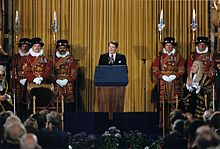
Together with the United Kingdom's prime minister Margaret Thatcher, Reagan denounced the Soviet Union in ideological terms. In a famous address on June 8, 1982 to the British Parliament in the Royal Gallery of the Palace of Westminster, Reagan said, "the forward march of freedom and democracy will leave Marxism–Leninism on the ash-heap of history". On March 3, 1983, he predicted that communism would collapse, stating, "Communism is another sad, bizarre chapter in human history whose last pages even now are being written." In a speech to the National Association of Evangelicals on March 8, 1983, Reagan called the Soviet Union "an evil empire".
After Soviet fighters downed Korean Air Lines Flight 007 near Moneron Island on September 1, 1983, carrying 269 people, including Georgia congressman Larry McDonald, Reagan labeled the act a "massacre" and declared that the Soviets had turned "against the world and the moral precepts which guide human relations among people everywhere". The Reagan administration responded to the incident by suspending all Soviet passenger air service to the United States, and dropped several agreements being negotiated with the Soviets, wounding them financially. As result of the shootdown, and the cause of KAL 007's going astray thought to be inadequacies related to its navigational system, Reagan announced on September 16, 1983 that the Global Positioning System would be made available for civilian use, free of charge, once completed in order to avert similar navigational errors in future.
Under a policy that came to be known as the Reagan Doctrine, Reagan and his administration also provided overt and covert aid to anti-communist resistance movements in an effort to " rollback" Soviet-backed communist governments in Africa, Asia, and Latin America. Reagan deployed the CIA's Special Activities Division to Afghanistan and Pakistan. They were instrumental in training, equipping and leading Mujaheddin forces against the Soviet Army. President Reagan's Covert Action program has been given credit for assisting in ending the Soviet occupation of Afghanistan, though the US funded armaments introduced then would later pose a threat to US troops in the 2000s (decade) war in Afghanistan. However, in a break from the Carter policy of arming Taiwan under the Taiwan Relations Act, Reagan also agreed with the communist government in China to reduce the sale of arms to Taiwan.
In March 1983, Reagan introduced the Strategic Defense Initiative, a defense project that would have used ground and space-based systems to protect the United States from attack by strategic nuclear ballistic missiles. Reagan believed that this defense shield could make nuclear war impossible, but disbelief that the technology could ever work led opponents to dub SDI "Star Wars" and argue that the technological objective was unattainable. The Soviets became concerned about the possible effects SDI would have; leader Yuri Andropov said it would put "the entire world in jeopardy". For those reasons, David Gergen, former aide to President Reagan, believes that in retrospect, SDI hastened the end of the Cold War.
Critics labeled Reagan's foreign policies as aggressive, imperialistic, and chided them as "warmongering", though they were supported by leading American conservatives who argued that they were necessary to protect U.S. security interests. The Reagan administration also backed anti-communist leaders accused of severe human rights violations, such as Efraín Ríos Montt of Guatemala, who in 2013 was convicted of genocide by a Guatemalan court.
1984 presidential campaign
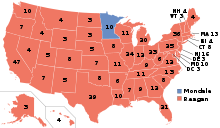
Reagan accepted the Republican nomination in Dallas, Texas. He proclaimed that it was " morning again in America", regarding the recovering economy and the dominating performance by the U.S. athletes at the 1984 Summer Olympics, among other things. He became the first American president to open an Olympic Games held in the United States.
Reagan's opponent in the 1984 presidential election was former Vice President Walter Mondale. With questions about Reagan's age, and a weak performance in the first presidential debate, his ability to perform the duties of president for another term was questioned. His apparent confused and forgetful behaviour was evident to his supporters; they had previously known him clever and witty. Rumors began to circulate that he had Alzheimer's disease. Reagan rebounded in the second debate, and confronted questions about his age, quipping, "I will not make age an issue of this campaign. I am not going to exploit, for political purposes, my opponent's youth and inexperience", which generated applause and laughter, even from Mondale himself.
That November, Reagan was re-elected, winning 49 of 50 states. The president's overwhelming victory saw Mondale carry only his home state of Minnesota (by 3800 votes) and the District of Columbia. Reagan won a record 525 electoral votes, the most of any candidate in United States history, and received 58.8% of the popular vote to Mondale's 40.6%.
Second term, 1985–1989
Reagan was sworn in as president for the second time on January 20, 1985, in a private ceremony at the White House. Because January 20 fell on a Sunday, a public celebration was not held but took place in the Capitol Rotunda the following day. January 21 was one of the coldest days on record in Washington, D.C.; due to poor weather, inaugural celebrations were held inside the Capitol. In the coming weeks he shook up his staff somewhat, moving White House Chief of Staff James Baker to Secretary of the Treasury and naming Treasury Secretary Donald Regan, a former Merrill Lynch officer, Chief of Staff.
In 1985, Reagan visited a German military cemetery in Bitburg to lay a wreath with West German Chancellor Helmut Kohl. It was determined that the cemetery held the graves of forty-nine members of the Waffen-SS. Reagan issued a statement that called the Nazi soldiers buried in that cemetery as themselves "victims", a designation which ignited a stir over whether Reagan had equated the SS men to victims of the Holocaust; Pat Buchanan, Reagan's Director of Communications, argued that the president did not equate the SS members with the actual Holocaust. Now strongly urged to cancel the visit, the president responded that it would be wrong to back down on a promise he had made to Chancellor Kohl. He ultimately attended the ceremony where two military generals laid a wreath.
